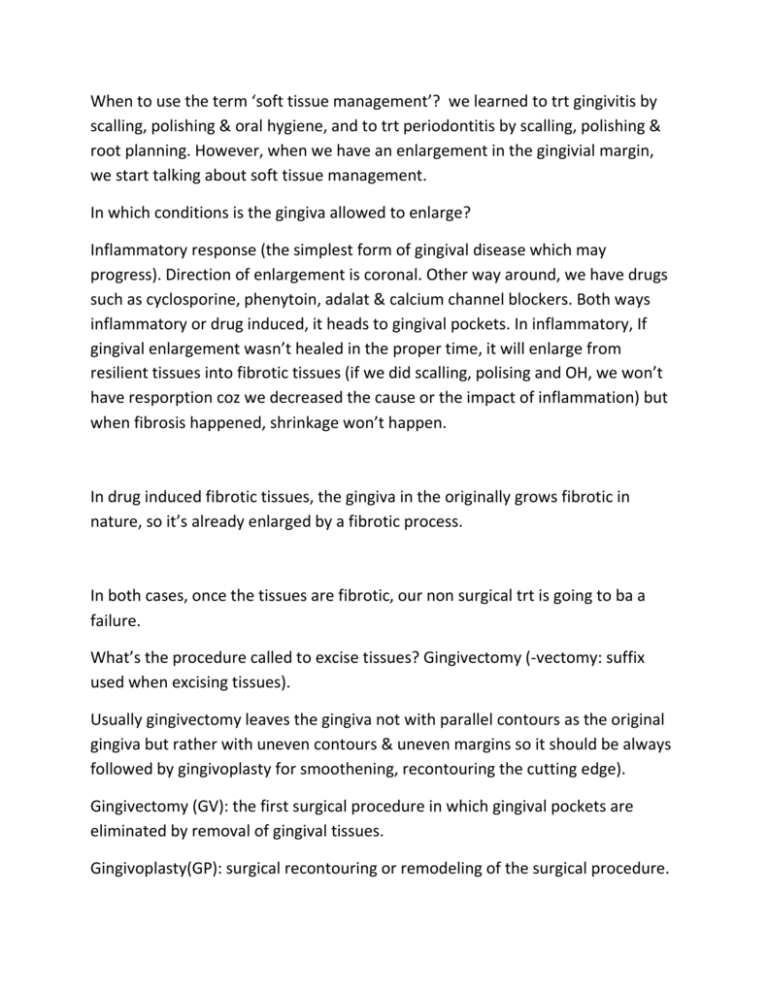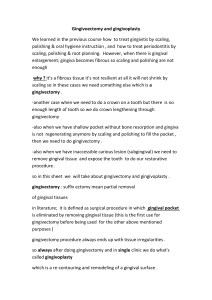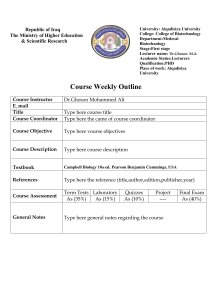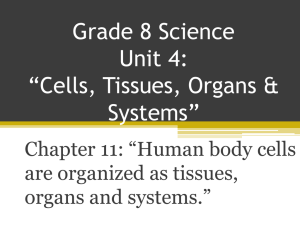PerioII,Sheet3,Dr.Nicola - Clinical Jude
advertisement

When to use the term ‘soft tissue management’? we learned to trt gingivitis by scalling, polishing & oral hygiene, and to trt periodontitis by scalling, polishing & root planning. However, when we have an enlargement in the gingivial margin, we start talking about soft tissue management. In which conditions is the gingiva allowed to enlarge? Inflammatory response (the simplest form of gingival disease which may progress). Direction of enlargement is coronal. Other way around, we have drugs such as cyclosporine, phenytoin, adalat & calcium channel blockers. Both ways inflammatory or drug induced, it heads to gingival pockets. In inflammatory, If gingival enlargement wasn’t healed in the proper time, it will enlarge from resilient tissues into fibrotic tissues (if we did scalling, polising and OH, we won’t have resporption coz we decreased the cause or the impact of inflammation) but when fibrosis happened, shrinkage won’t happen. In drug induced fibrotic tissues, the gingiva in the originally grows fibrotic in nature, so it’s already enlarged by a fibrotic process. In both cases, once the tissues are fibrotic, our non surgical trt is going to ba a failure. What’s the procedure called to excise tissues? Gingivectomy (-vectomy: suffix used when excising tissues). Usually gingivectomy leaves the gingiva not with parallel contours as the original gingiva but rather with uneven contours & uneven margins so it should be always followed by gingivoplasty for smoothening, recontouring the cutting edge). Gingivectomy (GV): the first surgical procedure in which gingival pockets are eliminated by removal of gingival tissues. Gingivoplasty(GP): surgical recontouring or remodeling of the surgical procedure. Gingivectomy is enhanced by subsequent gingivoplasty & during a single operation, gingival pockets are reduced & the remaining attached gingiva is given a physiological contour by gingivoplasty. GV & GP have some limitations & contraindications that limit its application; nevertheless, retains its effectiveness for localized gingival procedures. Prognosis (forecasting outcome of trt): the prognosis of gingivitis is good (treatable) The prognosis of periodontitis without bone resporption is good. Indications: (when we are allowed to do a certain gingivectomy): - Gingival enlargement (overgrowth) e.g. drug induced. Idiopathic gingival fibromatosis (very rare). Pseudopockets (coz all gingival enlargements lead to pseudopockets). Shallow suprabony pockets as in chronic periodontitis without bone resorption, so it’s a pocket without bone resoprtion, usually it’s treatable by scalling, polishing & oral hygiene & root planning we get reattachment, migration of junctional epithelium coronally & the pocket subsides, but why is it indicated for gingivectomy? Coz while we are cutting, we are eliminiating the suprabony pocket but there are cases of suprabony pockets not amenable as in the ‘periodontitis not amenable to trt’. If you treat it – no matter what you do – the pocket is still there resistant to treatment so what to do? To avoid the possibility of accumulation of plaque inside it, we reduce it, we eliminate it so that then we get lower sulcus depth as if the pocket is 5mm & we decided to eliminate 2 mm then we get 3 mm which is normal sulcus depth so in conditions as chronic periodontitis without bone resorption in cases that are not amenable to treatment. - Areas with difficult access to minor procedure, as in many class V’s, the cavity is equi- or sub-gingival correct it by minor corrective procedure (gingivectomay and gingivoplasty and expose areas with difficult access so we can gain access and do the cons case. Contraindications: - Narrow or absent attached gingiva (if the attached gingiva < 3mm whether anterior or posterior area). Why? Coz by this case, we are exposing his roots & it’s not esthetically nor ethically acceptable ( no sufficient width of attached gingiva). - Infrabony pockets as opposed to suprabony pockets, we’re not helping the patient coz we’re not treating the case, we’re just reducing the tissues (the pocket is still there & the bone resorption is still there). - Thickening of marginal alveolar bone, when we have bulging bone, not following the contour of the arch, we still do gingivectomy but we will expose bone, so what we do is that we open a flap & then do alveoloplasty, reduce thickening & suture. Advantages: - Technical simple & good visual access. (so easy to perform), as In crown lengthening. When a patient comes to you, & you don’t have sufficient height of clinical crown so you need to do crown lengthening, stupid enough to call a periodontist or a surgeon to do crown lengthening, you should it. And a patient with loss of many teeth for long time, the alveolar ridge is not straight (uniform) coz after extraction, they didn’t approximate the tissues so we have to do smoothening for the alveolar ridge so that you get the right impression and a stable denture so we do alveoloplasty for the marginal ridge and smoothen the area - Predictable morphological results: every procedure we do, we should predict the outcome of our work. In gingivectomy and gingivoplasty, it’s so easy to predict where to cut and how the tissues will look after our procedure. Disadvantages: - Very limited indications - Gross postoperative pain: If I bring a knife and cut into my hands, healing would be by first intention, while if I rotate it 45 degrees and cut into my hand, I’ll be going 1-2 mm (flap) & healing will be by secondary intention (will get scarring as granulation and fibrotic tissues). But if a surgeon has a good skilled hand or good cross infection, we won’t get fibrotic tissues. - Danger of exposing bone due to lack of experience, sometimes if we cut vertically more than allowed, we will expose bone & later on, there will be resorption and exposure of roots. - Loss of attached gingiva, if we have sufficient attached gingiva width, I need to remove fibrotic tissue, I will have to remove also 1mm of attached gingiva. So I have to evaluate is it worth to remove 1 mm of the attached gingiva with the fibrotic tissues or not? - Exposed cervical areas of teeth, phonetics and esthetic problems of anterior teeth. Patients with enlargement as in diastema people whose interdental papillae is inside their diastema, are habitualized to a pattern of phonetics as the number 999 (why this number? Coz when you say it, the tip of your tongue will touch palatal area of upper anterior teeth, if we remove that gingiva, we will impair the speech of the patient. So is it better to keep his speech or remove the enlarged gingivae? The doctor will convince the patient to remove the gingiva for his/her best. Instruments: Remember that the indication of gingivectomy and gingivoplasty is to remove pockets, how to know the depth of pocket? By probing but where to start cutting? The probe won’t tell you this….for this purpose, we use a puncture tweezer (one side is a probe and other side is a needle puncture), we put it inside the sulcus to its depth of pocket and then labially the needle puncture will puncture the gingiva to the depth marketed by its other end ‘probe’…so the depth of probe that’s measured will be the bleeding point on the other side….so depth of pocket corresponds to the bleeding point on the other side. Kinves: - kirkland kinves (left Kirkland and right Kirkland). - Orban Knives (one for both sides). Gingivectomy is done by knives, aslo by other instruments as electrosurge, aslo by a way that stopped (chemical gingivectomy) Chemical gingvectomy: it started in 1940, so they used to bring plates of asbestos & put it on the gum for 2-3 days, resulting in necrosis of tissues and shedding of enlarged tissues but later, the patients usually died due to asbestos so they stopped the chemical way. Cautery: tip just like orban, used after finishing cutting for smoothening of the area (couldn’t understand those few seconds)… papillae. Periodontal dressing: cutting by gingivectomy no matter which way we use, we will get healing by seconday intention so the gross wound we need to protect it by a periodontal dressing material leave it for one week and remove it later. Function of periodontal dressing: no function (not stabilizing the wound nor cleaning) it reduces discomfort of the patient only coz if it stays open, as the patient eats different types of food with different PHs may be acidic & it will pinch him. Types of periodontal dressings: - Zinc oxide non eugenol, it’s a base and catalyst ( equal proportions, mix it & apply it to wound) there fast and slow setting subtypes. - Light cure periodontal dressing as in composite, it has an excellent appearance that the patient sometimes cant differentiate it from his own gingivae, it has (dovetail) mechanical lock. - Sianoacrylate (medical surperglue) used when the tissues are so thin that when we suture them , they tear. Very good material. Case: A patient with phenytoin intake and thus gingival hyperplasia (not treated even if he has good OH and we did for him mechanical scalling, it will remain enlarged, so the option is gingivectomy. Remember drug induced gingival hyperplasia is multi-nodular, cauliflower like appearance and one stem. Treatment steps: - Infiltration anesthesia first. - Tweezer puncture (by deciding the depth first & then puncturing) we will get a series of bleeding points which indicate the place we have to excise. - Then bring Kirkland knife & put it below the bleeding points, why below not above? To ensure that we have eliminated the pockets, insert it 45 degrees to tissues, starting distal to the most distal bleeding point. - Then by Kirkland knife, we should touch the bone to ensue removal of all tissues, then by orban knife (triangular shape) we can insert it and it will cut mesially, distally the midline of the interdental papillae & will come out as one piece. So Kirkland knife to make the initial incision. Orban knife to reduce or eliminate interdental papillae area. Then we bring curette to remove uneven leftovers & then we do scalling polishing and root planning ( remember if the root is uncovered, it’s called root scalling and if covered root planning) to smoothen the area. - Then use Cautery (usually used to remove gum polyps and pulp polyps), to do gingivoplasty by electrosurge (we go from one side to another or in other words, electrical plasty). - Then bring Kirkland knife and scrap up the burned tissues. - It’s our option before applying dressing to apply antibiotic ointment not cream (coz cream is usually used for non mobile areas while ointment for mobile areas due retentive factors). - So we bring ointment (dentomycin ointment which is doxycycline ointment and apply it then cover the area). - The dressing is compressed in the interdental area and we get mechanical lock (leave it for one week and remove it later. Then after one week, we remove it, polish the area coz the patient was not able to brush the area & due to microleakage. Anas Al-Taee










